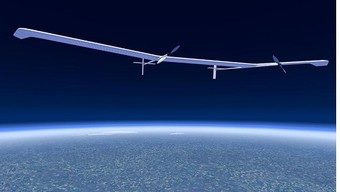National mapping agency for Great Britain and leading geospatial data organization Ordnance Survey (OS) has announced plans to launch a solar-powered drone that will fly at high altitude to complement existing satellite mapping systems.
The aim of the High Altitude Psuedo Satellite (HAPS) project, called Astigan, is to provide faster, higher quality images of Earth from 67,000 ft – almost twice the cruising altitude of a commercial airliner.
The platform weighs just 149kg and has a wingspan of 38 meters. Much like Airbus’ record-breaking solar-powered drone, the intention is for Astigan to be a middle ground between conventional satellite systems and your average UAVs.
Eventually, it will fly for 90 days at a time without needing to land – enough time to circle Earth four-and-a-half times.
Positive news for UK tech amid Brexit uncertainty
Plenty of businesses are holding off on big investment decisions or leaving the UK entirely amid the uncertainty of Brexit. The project’s progress is a rare nugget of positive news for the UK Government.
Business Minister Lord Henley said, “The UK has a particularly successful track record in mapping and associated technology. This exciting new unmanned aircraft project is a brilliant example of the innovative thinking behind our modern Industrial Strategy and should lead to global business opportunities.
“As well as having the potential to support key government objectives such as upgrading the UK’s infrastructure, it could benefit emerging technology areas such as smart cities and self-driving vehicles which both rely on accurate 3D mapping.”
Since 2014, the Astigan project has collaborated with a range of British SMEs, industry experts and universities. Eight full scale flights have already been completed. The Astigan team says it has the potential to work alongside existing mapping capabilities to revolutionise the speed, accuracy and cost involved in mapping a country.

Astigan’s ambitious development targets
Brian Jones, Astigan Managing Director, has confirmed that full testing and endurance flights will take place later this year.
“This remarkable aircraft has met every goal and passed all milestones in its ambitious development programme so far,” he said. “We are excited about the year ahead as we increase our flights and move towards a fully operational high-altitude test. By the end of 2019 we aim to be completing endurance flight testing, building up to 90 days non-stop, which is the operational capability we’re striving for.
“It’s incredibly exciting that the UK has developed this kind of technology, delivering satellite capabilities, unparalleled flexibility and improved efficiency, all at a vastly reduced cost. We look forward to completing this project and seeing the aircraft deliver on its outstanding potential, which should provide a range of scientific and environmental benefits.”
Beyond mapping
Geospatial data and mapping derived from aerial imagery capture is only one example of Astigan’ potential. The team also says the technology can be used for climate and environmental monitoring, keeping a close eye on the polar ice caps or deforestation, for example. It could also provide localized and persistent early warning, observation and communications from high above natural disasters.

Neil Ackroyd, a Co-Founding Director of Astigan and Acting CEO of Ordnance Survey, said: “Astigan is another example of OS being at the forefront of geospatial technology. The platform has been designed to offer major cost and efficiency advantages over traditional methods. The company has produced a unique, British-made platform which can carry a range of interchangeable earth observation instruments such as high-precision cameras, atmospheric monitoring systems and multi-spectral sensors.
“Astigan supports Ordnance Survey in enhancing its capabilities to work in partnership with other nations across the globe. By aligning this capability with our world-class geospatial production and mapping expertise, we hope to support organisations and countries in tackling major societal challenges including urbanisation, land management, environmental change and mapping to support emergency response in the case of natural disasters.”
Malek Murison is a freelance writer and editor with a passion for tech trends and innovation. He handles product reviews, major releases and keeps an eye on the enthusiast market for DroneLife.
Email Malek
Twitter:@malekmurison
Subscribe to DroneLife here.







[…] early-stage example is Global Hawk – a high-altitude/high-endurance UAV, which was developed in the mid- 90’s with a consortium consisting of DARPA (lead technology […]